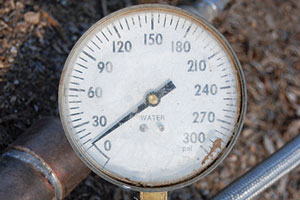Final Comments on Bladder Tanks

|
| A “wider” pressure range can mean more water in the tank, but columnist John Schmitt is skeptical it can make up for a weak well or pump. |
As I make my final comments about bladder tanks let me quickly review the subject. These tanks are certainly a wonder and, along with the submersible pump and the pitless adapter, are, in my opinion, the great advances to the well water supply industry in the last 50 or 60 years. Although bladder tanks on occasion will cause taste and odor problems in the water, they are so far ahead of any other hydro pneumatic tank it is not even funny. Certainly bladder tanks, along with lightening arrestors for motors, have saved many, many pumps from a premature death, usually from short cycling. While bladder tanks are not perfect, they are way out ahead of whatever is in second place. I have heard them purported to be the answer to a low-capacity well or an under-capacity pump. With this, I must disagree.
Several years ago I attended an NGWA Convention and one of the key bladder tank manufacturers had a tank on display they said was the answer to the weak well. What they had was a tank equipped with, I believe, a special pressure switch that was set for the pump to come on around 25 psi and shut off at 75 psi. In the area that I work in, typical pressures now-a-days are on at 30 and off at 50 and recent years more often than not on at 40 and off at 60. Now, by going to a far wider pressure range, any given tank will provide more water on a cycle. All tanks must obey the laws of physics no matter who the manufacturer is. A bladder tank set at 40/60, for instance, will accept or yield only 26 percent of its total capacity per cycle. By going to on at 25 and off at 75 we can increase this to 53 percent of its total capacity or just a little over double the 40/60 setting.
I’m not sure systems set as low as 25 psi will yield much water at the faucet considering the water conditioning equipment we use nowadays and also the federal mandated faucet restrictions. However, as this manufacturer recommended, by going to the “wide” pressure settings we certainly could increase the amount of water in our tank. I think the manufacturer even provided a special pressure switch as I don’t think you can set a normal pressure switch to start/stop at 25/75. I don’t remember the special switches being available if replacement was required either.
In any event, if we took a tank of about 87 gallons, a popular large size, and installed three of them and set them at 25/75 we would have 138 gallons stored up. If we went to three jumbo tanks of 119 gallons and the same pressures we would have 189 gallons stored up. Now the average family, I am told, uses between 50 and 100 gallons per day per person for all purposes — bathing, cooking, toilet flushing and clothes washing. The problem is that about half of this water is used in a short period of time in the morning and a somewhat longer period of time in the evening. In between, the family members are either at work or school or at least not at home. If our family has four members they might need from 200 to 400 gallons of water a day. With three jumbo tanks we could meet that 200 gallons or get very close. We have to remember that even a slow pump will provide some water while it is running so this set-up quite possibly could meet the needs of our fictitious family with one huge exception.
We have no way of knowing if our tank pressure is 74 psi when the first person starts to shower at 5:45 a.m. or it is at 26 psi at that same time. If the tank is full and the pressure is up there is no question that the stored up water under pressure will very much help the needs that a slow pump can’t do. But again, I repeat, we have no way of knowing at what pressure the system will be when usage begins. In the year 2015, perhaps there is some smart engineer or computer guru that could figure out how to have the pump run and build up 75 psi everyday at, say, 4 a.m. and then this system would really work. Perhaps such a reset system is available but I have never seen one.
About the only way we can really store up water in our supply system is to fill a tank or tanks with unpressurized water and then build up pressure with a second pump. Using this system, our three tanks would hold 360 gallons and would easily meet our fictitious family’s needs. Please don’t think this is a denunciation of bladder tanks, it’s just that I don’t think this manufacturer thought the process through very well and I think I only saw this setup at one convention. Next time, if I don’t get sick, I will move on to a whole new subject.
You will be reading this in early 2015 and I hope 2014 was successful for you and you had a great holiday. As this is written just before Christmas, I have stopped mowing lawn and have a snow blade on my tractor. We have absolutely no snow on the ground. I did see a fellow mowing lawn last Sunday, although he may have been chopping leaves.
For more John Schmitt columns, visit www.thedriller.com/schmitt.
Looking for a reprint of this article?
From high-res PDFs to custom plaques, order your copy today!

